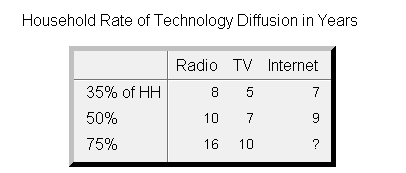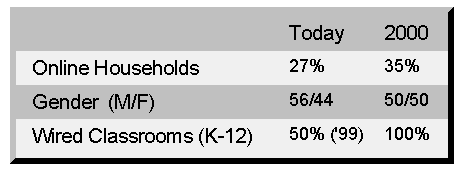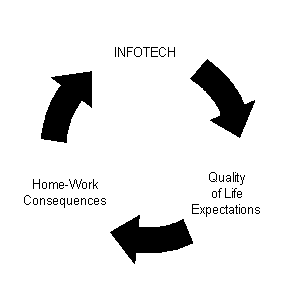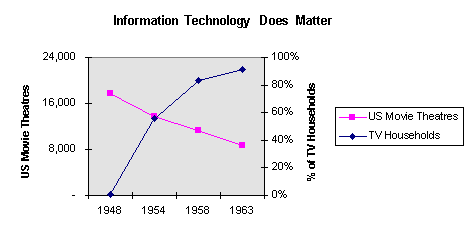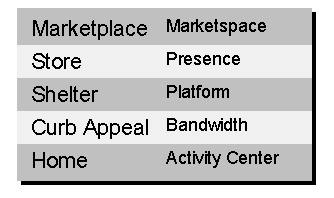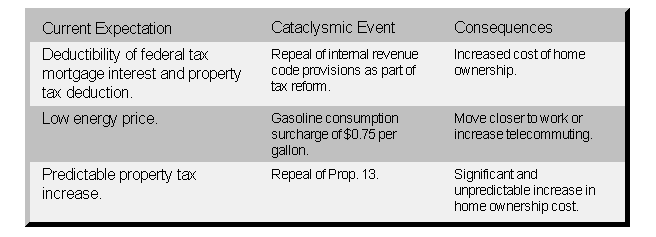Advice from the Experts SEPTEMBER 1998 A New Sense of Place: By Mark Borsuk Panel Discussion The Impact of Technology on Real Estate Development Wednesday, June 24, 1998 PCBC Western Building Show
A New Sense of Place: I. INFOTECH’s consequences for home builders.
II. INFOTECH unleashes new expectations. A. How do changing expectations about information technology impact:
INFOTECH heralds the transition from high-tech to everyday-tech1. The use of information technology is a mass market phenomenon. INFOTECH is the integration of computer hardware, software, networks and telecommunications into daily life. One manifestation of INFOTECH is the Internet. The ubiquitous telephone line makes individual Internet access possible. The Internet’s diffusion through society is rapid and resembles television’s swift arrival into the home in the 1950s. It only took TV seven years (1948-1954) to reach 50 percent of households. 2
C. The trend is clear. Most forecasters expect about 35 percent of US households to be online by the year 2000. 3 Put another way, it has taken only seven years for online households to reach the same level of penetration that TV households did in five years. The diffusion has been rapid despite the greater complexity and steeper learning curve required to access the Internet. By 2002 wired households could reach 50 percent. In California, the household diffusion rate will be higher and arrive earlier due to the population’s predisposition to embrace INFOTECH. 4 The role of women online is rapidly changing. The online population is quickly moving to gender parity.5 Internet demographics now mirror the population as a whole.6 Getting online is de rigueur with teenagers. Approximately 65 percent of 12-19 year olds currently access the Internet.7 Further spreading the use of the Internet is the national policy is to wire the nation’s primary and secondary schools. The target is half the classrooms to be Internet ready by 1999 and by 2000, to have 100 percent of the classrooms online.8 Follow the Trend
In addition, INFOTECH moves the work to the workers. A mobile workplace benefits employees by offering greater flexibility in scheduling home and work commitments, less time spent commuting, and improved job satisfaction. Employers reap the benefits of higher productivity, employee retention and a reduction in occupancy costs. III. INFOTECH changes the role of the home. INFOTECH no longer requires a shop to go shopping, a workplace to work, or a school to learn. INFOTECH creates new forms of education, work and shopping. Society’s adoption of information technology also changes expectations about where and how to work and shop, the location and duration of education, and how government policies advance or hinder the transition to the Information Age. Changing expectations about these issues place the home in a new role. In other words, INFOTECH allows one to expect a higher quality of life centered around the home. INFOTECH Drives Expectations
Because of INFOTECH, the home’s role is greatly expanded. It now must be an activity center where work, shopping and learning coexist within the shelter. Increasingly, the home is also a technology platform. INFOTECH Changes the Home’s Role
INFOTECH will influence home buyers by changing their expectations about how the home improves the quality of life. The PC and the Internet are replacing the automobile as factors influencing life-style. In a wired world personal mobility takes on a new meaning and generates new expectations. IV. Work in a Wired World. A hallmark of the Information Age is organizational change.9 INFOTECH restructures the command and control organization into a flatter, networked system of relationships based on teams, and core and contingent employees. Home building is a good example of what corporate America is seeking to achieve: the developer, general contractor and subcontractor model. The parties come together on a project "when needed" to fulfill a specific goal. Upon completion the relationship dissolves until a new project. Organizational continuity resides with the developer’s core team. California’s role in setting trends also has profound implications for housing. INFOTECH, by allowing jobs to follow the people, creates the networked organization.10 The movement to an Alternative Workplace ("AW") strategy by large corporations embodies this technological leverage.11 Already, 30 million to 40 million people are either telecommuting or home-based workers,12 and California leads the way. Wired workers represent 57 percent of California workers. They have a strong preference for flexible work schedules and 30 percent would prefer to telecommute all the time.13 The number of employees communicating with their offices by computer and fax is 20 percent higher than the national average. In cities like Oakland, San Jose, San Francisco, Santa Cruz-Watsonville, and Santa Rosa the number of employees is 46 to 73 percent higher than the national average.14 The AW movement recognizes many employees no longer need the degree of supervision traditional managers one thought essential. They can perform their jobs in a largely self-directed manner. AW requires information literacy. The movement also knows many business tasks do not require the aggregation of employees at a central location and AW is necessity to retain highly motivated people. An AW strategy increases employee productivity.15 Conversely, productive employees expect AW amenities. One intangible benefit of AW is the value employees place on increased personal time and control. Commuting to the office is seen as an unproductive, morale sapping, debilitating ritual whose time has passed. Increasingly employers will encourage more time spent at telecommuting centers or in the home-office for many knowledge workers. V. Education in a Wired World. INFOTECH creates on-demand, universal education for children and adults. School is no longer constrained by location, time or age cohorts. Forward thinking parents will use the home learning center to develop their children’s intellectual capital.
INFOTECH allows students to study independently, remotely and conveniently. Very shortly a significant portion of primary and secondary education is likely to shift to the home.16 A hypothetical example illustrates how education benefits in a wired world. Publishers offer "Homework.com" to supplement their school texts. Teachers, as part of their lesson plan, assign drills, optional materials and remedial exercises to students. The material is accessible online from the public library, the home, or wherever there is access. By supplementing the school curriculum with self-paced materials, teachers can give students greater opportunities to strengthen their skills and pursue knowledge.17 INFOTECH makes the Internet University a reality. Already course outlines and reading lists are available online. Many courses will be digitally recorded allowing students to access them whenever convenient. Class projects are done remotely and papers submitted via email. It will be possible for students not enrolled in the University to take classes over the Internet. This will be a boon for schools to generate additional revenue and confer superstar status to gifted professors who can develop a national and international following. 18 INFOTECH’s ability to bring Life Long Learning to adults is equally important. The far flung nature of the Internet is an incentive for public and private institutions to provide a vast array of courses for free or fee based. 19 The modularized instruction will adapt to each individual’s needs and pace of learning. "Leisure Learning" will be available to older adults who are unable to pursue their interests due to physical disability, inability to attend class or distance.20 The home will once again be the classroom of choice for many. VI. Shopping in a Wired World. Buying online is an emerging shopping pattern. Just like the transition from full service to self-service shopping after 1945, consumers are learning the benefits of shopping online. The vast number of branded goods and services available offer customers assurance. The trend of shopping from home will accelerate over the next several years as women become the majority of online buyers. Already, America Online’s membership is 52% female.21 The growth of online buying portends a shift away from retail properties like Big Boxes, community centers, and stores offering little or no service.22 An example of INFOTECH’s potential to devastate retail real estate lies in the history of movie theaters. They declined significantly as TV rapidly entered the home and the suburban migration grew. The Chart illustrates the 50 percent drop in theaters over fifteen years while the number of TV households rocketed from less than 1 percent to 90 percent. The tremendous popularity of TV, coming at the time of suburban migration, decimated movie theaters. The rapid decline in movie theaters induced by the diffusion of information technology holds an important lesson for home builders. The population’s growing dependence on INFOTECH requires builders to adapt their homes to the dictates of the information age or face market rejection by offering a less useful product.
While Amazon.com, the book seller, captures the popular imagination, a greater shift is likely to occur in the mundane purchases of everyday items like non-perishable groceries and personal care products. A new term, "Bundle Buying" will emerge to signify the choices available online from aggregators who combine the best products from say a Safeway grocery store and a Walgreen’s drugstore. Purchases will flow from regional fulfillment centers and the resulting economies of scale add little or no cost for home delivery. Over the next several years various forms of online buying will entice consumers to change their shopping habits and make the home the shopping center for everyday products, branded goods and restocking items. This, however, does not change the preference of recreational and specialty shopping outside the home. A related activity, personal finance, is about to undergo a sea change. Today, banking online is an option several million households choose. However, many more households are waiting for bill presentment.23 Bill presentment combines home banking with electronic payments. Credit card, utility and other typical charges will be payable through the customer’s checking account over the Internet. VII. The Home as Activity Center. A. What’s moving home? Studying, shopping and working in the home existed before INFOTECH. However, INFOTECH introduces a quantitative and qualitative difference.24 First, the Internet promotes a broader range of activities from home. Second, the quality of what can be accomplished continues to increase. Finally, wired families can buy back time, a precious commodity, by spending less time coming and going. In the case of education, the home can take on the role of public library and a skill building center for improving math, reading and writing. All on-demand and self-paced. In the case of shopping, the home becomes a show room for many items, a comparison shopping center and convenience store. In the case of work, the home becomes a venue for undertaking complex tasks in an island of tranquillity and still affording the opportunity to maintain contact with colleagues. The side benefits to home owners are fewer trips and less time spent driving. B. Sustaining the value of the activity center. The activity center concept also relates the home design to an environment for accommodating multigenerational families. The greater the number of universal design elements incorporated into the structure, the greater the value for children, the elderly and handicapped.25 Wider doors, the elimination of entrance steps, more emphasis on conveniently locating light switches and electrical outlets, and better designed bathrooms all will contribute to enhancing the home as activity center. VIII. The Home as Technology Platform. A. The home as a legacy system. INFOTECH no longer permits constructing "dumb" homes. New homes need a wiring infrastructure capable of delivering bandwidth, i.e., high speed voice, data and video, to every room. Homes lacking this amenity will suffer a stigma. They will be seen as a throwback to the Industrial Age. In other words, a home is no longer defined solely in terms of shelter. INFOTECH gives residential property a new purposes and use. Bandwidth will help define a home’s functionality and value. B. Use new metaphors to think about the evolving role of the home. Tired & Wired Metaphors
C. Reengineering the home. Home builders need to pre-wire for bandwidth. One example is the Lucent Technologies HomeStarÒ Wiring System.26 The addition of Enhanced Category 5 copper telephone cable and RG-6 two-way, coaxial cable increases the building cost by just a few thousand dollars, but greatly enhances value. 27 Contractors should also add an extra conduit coming onto the property for future expansion, e.g., fiber optic. The conduits entering the property need to be of sufficient diameter to accommodate additional cabling. Developers need to consider what additional infrastructure the Telcos and Cable companies will build into the neighborhood to offer greater bandwidth when designing the project. While it is likely that over the next five to ten years wireless technology will make in-home wiring partially redundant, homes lacking an upgraded bandwidth today are at a competitive disadvantage. Home builders should also place the work/study area where it offers the most natural light and sound proof the space. Adding a secure delivery door for parcels, groceries and other bulky items anticipates the growth of online buying. Building for the multigenerational family recognize the household life cycle. The ideas discussed above only begin to address the changing role of the home in the Information Age. Builders will create many more refinements and profit opportunities as they focus on INFOTECH’s impact. IX. Government Policy. While the introduction of INFOTECH into the home adds value, it will likely cause other changes impacting home ownership. They may not all be favorable. Examples are taxation and space use planning. A. Tax policy. Federal income tax law is a product of the Industrial Age. The Federal taxation of income was sanctioned by the Sixteenth Amendment to the Constitution in 1913. Moving to the Information Age requires a fundamental restructuring of the tax system. A simple, flat-tax or consumption tax system is often discussed. One feature would be the removal of the home mortgage interest and property tax deduction.28 Another revenue raising idea is to surcharge gasoline for environmental degradation and infrastructure maintenance costs. Also, the expansion of public transportation might become a higher priority. State and local tax policy is likely to feel the strain of the Information Age. Online buying could trigger a significant decline in retail sales tax revenues for state and municipal governments.29 In California there is a heavy reliance on retail sales taxes for revenue.30 Where could government go to fill the short-fall? One possible source of new revenue is the repeal of the Prop. 13, the limit on property tax increases. During the June’98 election primary a number of articles appeared discussing the harmful effects of Prop. 13. Is this a harbinger for repeal? What would happen to home building if mortgage interest and property taxes were no longer deductible, government could raise property taxes at will and gasoline went to $2.00 a gallon? Triple Whammy for California Homeowners
New housing developments would benefit if they were in close proximity to employment, shopping and high quality public transportation. Such a drastic economic change could also shift the economics of home development in favor of leasing land instead of purchasing it outright. Expectations about the long-term value of home ownership might shift in the Information Age. B. Planning Policy. INFOTECH offers an improved life-style for many people that is less automobile dependent. Many seek communities to live a less stressful life-style, where employment and shopping are close at hand. INFOTECH begins to sever the car-as-human-prosthesis relationship and the resulting problems of sprawl, air and water pollution, and traffic congestion. Since many people symbolically associate the automobile with freedom and mobility, it is counter-intuitive for them to believe less reliance on the car is beneficial. The home’s expanded role can act as a catalyst for changing this mindset. Unfortunately, the home’s changing role will create other issues for cities and towns. Communities will have to resolve the restrictions on working in the home, delivery vehicles on residential streets, zoning, and taxation of commercial activities before they can fully integrate INFOTECH’s benefits.31 A changing emphasis in retailing may be paralleling developments in the home. One developer is creating a LIFESTYLE CENTER designed to be in close proximity to where people live, to provide a greater sense of familiarity and security and to target the primary shopper instead of seeking to draw customers from great distances.32 The ideas underlying the LIFESTYLE CENTER and those related to the home as activity center suggest significant changes ahead for residential development. X. Catching the Third Wave. INFOTECH describes one aspect of the Information Age. It is not a fad, buzzword, or slogan. Rather, it is a way to conceptualize change, understand the momentum of change, and provide a glimpse into the near future. Home builders are in a unique position to capitalize on the trend by reengineering the home today for tomorrow’s uses. Most design and accouterment changes are minor in scope and cost. However, they will offer rich rewards for builders who connect with the needs of the wired buyer. (Revised 8/8/98) 1 Howard Anderson, The War Ahead: Technology goes
mainstream, UPSIDE, July 1998, pp. 111-116.
*Mark Borsuk borsuk@ix.netcom.com is Managing Director of The Real Estate Transformation Group, a firm advising landlords, retailers and lenders on strategies for the Information Age. In addition to consulting, Mr. Borsuk is a retail leasing broker and real property attorney practicing in San Francisco. **Copyright © 1998. Mark Borsuk. All Rights Reserved, except the reader may copy this article into electronic form or print for personal use only, provided that: 1) the article is not modified; and 2) all such copies include this copyright notice. News Releases | Articles | Upcoming Talks | Memorable Quotes Copyright ©1995 - 2020. Mark Borsuk. All rights reserved. Disclaimer notice |




